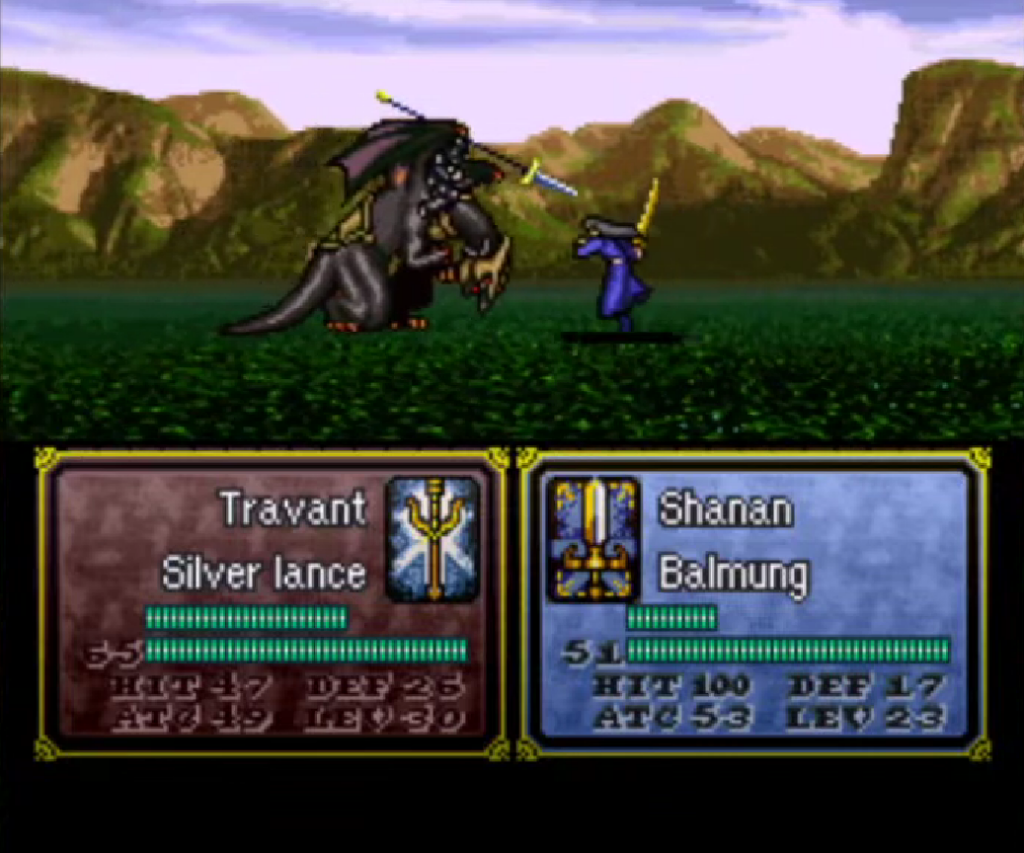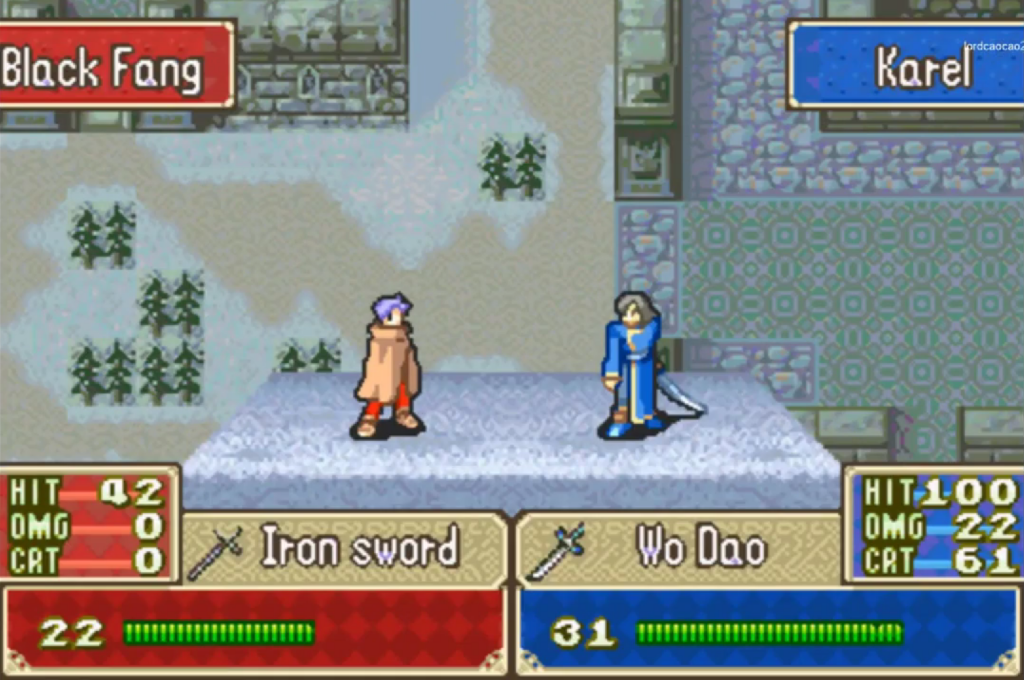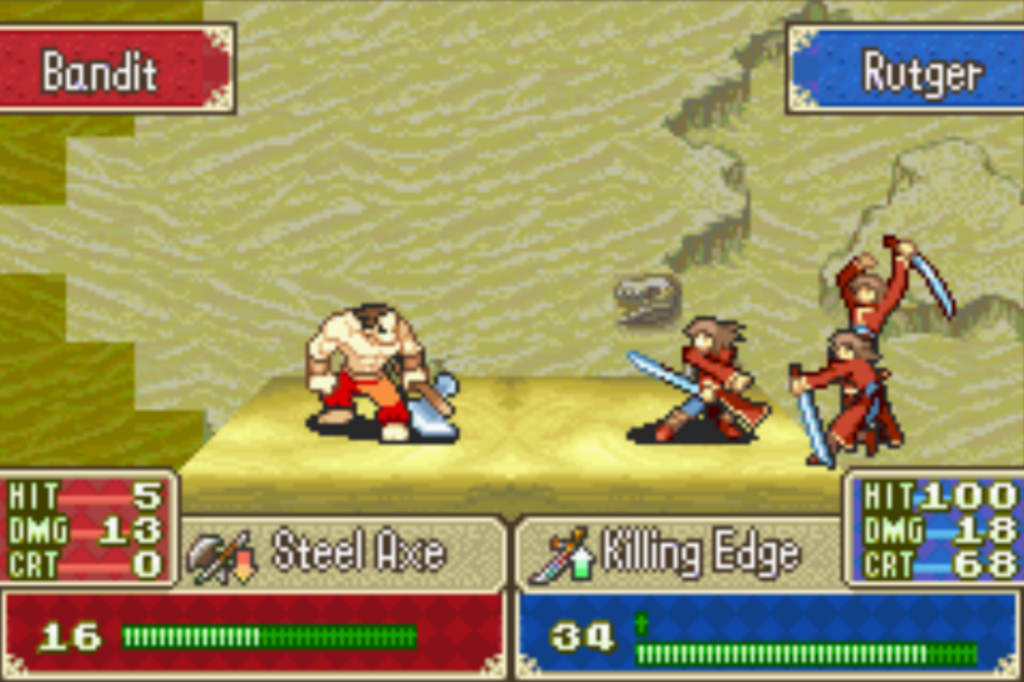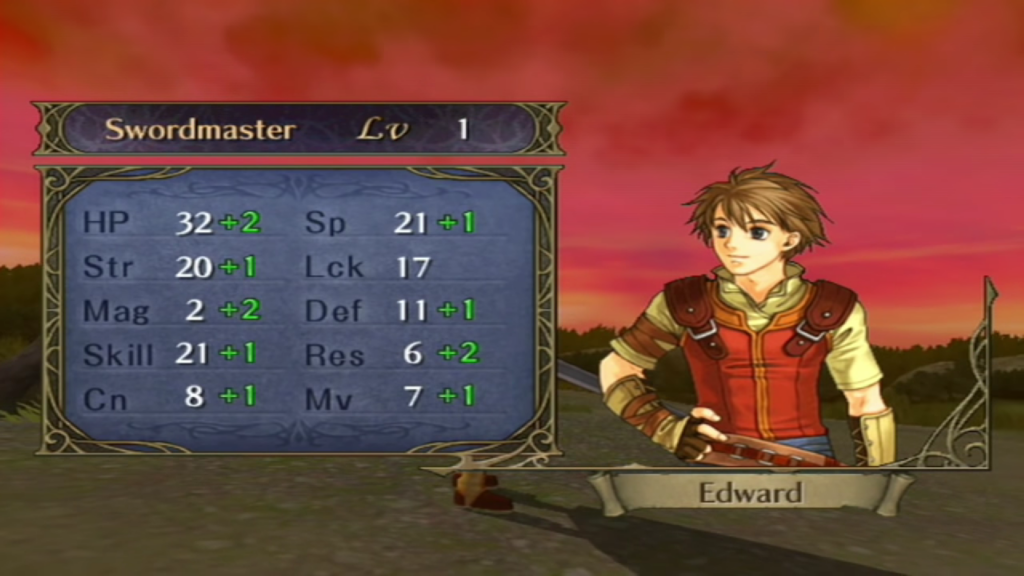- Fire Emblem Wyvern Rider - June 23, 2022
- Fire Emblem Assassin - June 8, 2022
- Fire Emblem Wyvern Lord - June 8, 2022
Intro
Many classes in Fire Emblem can use Swords. But as the name suggests, the Swordmaster is the Sword-wielding class in Fire Emblem.
When I was growing up, many of my favorite shows were anime heavily focused on sword combat, like Rurouni Kenshin and Samurai Champloo, and I developed a fondness for all things samurai-related. And seeing as how Swordmasters feel more like Far East samurai in their design and weapon choice than the Western-themed classes like Cavaliers and Knights, I was naturally drawn to them. No matter what place they fall under in any given Fire Emblem tier list, I always have at least one Swordmaster that I actively use.
But personal bias aside, how would I rate the Swordmaster class overall? Sure, they might be the coolest Sword-wielding class in Fire Emblem, but are they the best? After all, performance is what really counts in a series like Fire Emblem, where the difficulty leans towards hard territory more often than not.
I guess there’s only one way to find out. Let’s dive in, shall we?
History of the Swordmaster
The Swordmaster made its debut as one of the promotion options for the Myrmidon (Alongside the Forrest class) back in Genealogy of the Holy War. Shannan is the first pre-promoted Swordmaster in the series. The Swordmaster was again a promotion option for Myrmidons in the follow-up Thracia 776. The Mercenary class was also a promotion option for Myrmidons before permanently becoming a tier 1 class.
As one of the more stable promotion lines in Fire Emblem, the Myrmidon’s promotion into the Swordmaster has been consistent throughout the series. In The Binding Blade and The Blazing Blade, the Swordmaster was the only promotion for Myrmidons. In The Sacred Stones, Myrmidons could promote into either Swordmasters or Assassins. In the Tellius Saga games, the Swordmaster class continued to be the de factor promotion class for the Myrmidon. The only difference made to the formula was the addition of the Trueblade in Radiant Dawn. Radiant Dawn introduced numerous tier 3 promotions, with the Trueblade being the promotion for the Swordmaster.
Swordmasters found their way into Shadow Dragon and New Mystery of the Emblem, remakes of the first and third games (Which didn’t have the Swordmaster class), and Awakening. Awakening also regave Myrmidons the option to promote into Assassins instead of Swordmasters for the first time since The Sacred Stones.
Fates finally introduced the Samurai class to the series, with them naturally promoting to Swordmasters (Or optionally Master of Arms). As you would expect, Swordmaster is one of the many promotion classes in Three Houses provided you pass the Certification Exam with an A rank in Swords and have a Master Seal.
Skills of the Swordmaster
The Swordmaster hasn’t garnered many different skills over the nearly three decades the class has been in Fire Emblem. As crit specialists, most of their skills center around making them crit more.
Follow-Up
A combat skill in Genealogy of the Holy War, Follow-Up allows users to perform a follow-up attack on an opponent if they have a higher Attack Speed than their enemy.
Adept
Adept is a class skill of the Swordmaster (And several other promotion classes) in Genealogy of the Holy War and Thracia 776. With an activation rate based on Attack Speed, Adept allows users to initiate a consecutive attack.
Critical+30
In The Binding Blade, Swordmasters have an additional 30% added to their Crit Rate. It’s what makes Rutger so broken and arguably the strongest character in FE6. Rutger’s base Crit Rate with a Killing Edge as a Swordmaster is 60%.
Critical+15
Intelligent Systems immediately nerfed the Swordmaster’s critical bonus in The Blazing Blade by reducing it by 15%. Critical+15 is still a nice class bonus, but it noticeably weakened the Swordmaster.
Swordmasters in The Sacred Stones also have Critical+15 as a class skill.
Astra
Astra is a recurring skill for the Swordmaster class in the series, and it has had its ups and downs.
Astra is an occult skill of the Swordmaster in Path of Radiance and the class skill of the Trueblade in Radiant Dawn. Path of Radiance’s Astra isn’t that great. It gives the user a chance to perform five consecutive attacks but with only half of their attacking power. With Strength being one of the Swordmaster’s greatest weaknesses, the last thing you want is less attack power.
Astra is significantly better in Radiant Dawn. It still gives the user a chance to perform five consecutive attacks but at full power this time. As a drawback, critical hits do not proc when using Astra. In Awakening, Astra again deals only half damage when it activates, which is unfortunate. On the positive side (The Victor Lucas in me is coming out), Astra only takes up one use of your weapon.
Fates and Shadows and Valentia maintain the same skill effect except for the one weapon use factor. In Three Houses, when Astra activates, your attacks only have 30% Might.
Critical+10
Intelligent Systems continued the trend of nerfing the Swordmaster’s Crit Rate bonus, reducing it from +15 to +10 in FE10.
Shove
Shove is a basic skill that all non-mounted units can use in Path of Radiance and Radiant Dawn. It allows users to push an adjacent target one tile away. It’s useful in a couple of situations.
Swordfaire
Swordfaire is a high-level skill of the Swordmaster in Awakening, Fates, and Three Houses.
In Awakening, it gives +5 Strength or Magic while a Swordmaster has a Sword or Magic Sword equipped. In Fates, Intelligent Systems changed this to +5 damage. Finally, in Three Houses, they changed it again to +5 Might.
Sword Critical+10
After achieving an S rank in Swords, Swordmasters in Three Houses gain a +10 Critical Rate while using a Sword.
What Makes A Swordmaster?
Skill and Speed are how Swordmasters approach combat. They almost always have a high Hit Chance, even against Lance-users, and will double everyone except the fastest enemies. Even when facing enemies in terrain, you can count on Swordmasters to be accurate. The standout strength of the Swordmaster is their innate Critical Rate bonus. With a Killing Edge or Wo Dao, they have extremely high crit chance, and even without, substantially higher crit chance than other units. And this really comes in handy against one enemy type in particular: bosses.
It varies depending on the game, but Fire Emblem is a pretty difficult series. Bosses on thrones have some hefty bonuses to their attributes and often require a team effort to take down. Supereffective weapons make things easier, but you won’t always have one on hand, or the boss isn’t especially weak to anything. The safest strategy against many early to midgame bosses would be slowly whittling them down with Magic and ranged attacks. That is unless you have a Swordmaster. These guys and gals are essentially a cheat code that allows you to punch up against tough boss enemies thanks to their high crit chance.
The Swordmaster’s crit talent, however, is a double-edged sword. Most Swordmasters have pretty good base Strength but average/poor Strength growth rates. They may be fine when they join but will fall off significantly in the endgame. They may end up heavily relying on critical hits to do good damage. Worst case scenario, they will fail to one-round opponents with high HP and Defense, even if both hits are criticals. As you progress further into the game, Heroes and Paladins will be more reliable Sword-users. Swordmasters also have poor Defense and even worse Resistance, so you don’t want to overexpose them in combat. The best thing you can do for them is to place them in terrains like forests or forts. Lance-users and Magic-users hit them very hard. While Swordmasters have good HP growths, they still have low HP and cannot take many hits.
Something that really hurts Swordmasters, specially pre-promoted ones, is their join time/availability. Swordmasters aren’t the most common early game units, and quite a few join in the mid to late midgame. You will likely have already been training a Myrmidon or two, and they will end up better than the pre-promoted Swordmaster. Other Swordmasters join so late, like Karel in FE7, that they will barely be able to contribute, which cancels out how good they are.
Swordmasters can only use Swords as weapons, and that definitely hurts them in a series than loves throwing Lance-users at you. They’re unable to defend themselves against Ranged attacks except with the use of Magic Swords, but that comes with a drawback. They aren’t able to make use of their high crit chance when using Magic Swords. Seeing as how many Swordmasters can struggle with Strength growths, they will be quite weak when attacking with Magic Swords. And when you take into account how rare Magic Swords generally are, you could argue it isn’t worth giving Swordmasters any.
Swordmasters have pretty mediocre Movement, and that really hurts them in games with large maps like Genealogy of the Holy War and Thracia 776. While they make for great boss killers, they often need to be taxi’d because they take too long to get to the boss themselves.
How Many Playable Swordmasters Exist In Fire Emblem?
Fire Emblem has had 25 playable Swordmasters so far, though many are SpotPass characters in Awakening.
- Shannan (Genealogy of the Holy War)
- Eyvel (Thracia 776, Awakening)
- Shannam (Thracia 776)
- Karel (The Binding Blade, The Blazing Blade, Awakening)
- Karla (The Blazing Blade)
- Ismaire (The Sacred Stones)
- Stefan (Path of Radiance, Radiant Dawn, Awakening)
- Lucia (Path of Radiance, Radiant Dawn, Awakening)
- Zihark (Radiant Dawn)
- Mia (Radiant Dawn)
- Say’ri (Awakening)
- Yen’fay (Awakening)
- Navarre (Awakening)
- Deen (Awakening)
- Athena (Awakening)
- Ayra (Awakening)
- Seliph (Awakening)
- Larcei (Awakening)
- Mareeta (Awakening)
- Lyn (Awakening)
- Marisa (Awakening)
- Lloyd (Awakening)
- Ryoma (Fates: Birthright, Revelation, Warriors)
- Catherine (Three Houses)
- Byleth (Three Houses)
Is The Swordmaster Class good?
The Swordmaster class is decent. The primary problem is it’s too niche and often falls off once you start getting out of the midgame.
How well Swordmasters turn out heavily depends on their Strength growth when they level up. If RNG does a doozy on you, then their attacks will do pretty underwhelming damage if you don’t land crits. This can be especially problematic for pre-promoted Swordmasters with fewer levels to level up than a promoted Myrmidon.
Swordmasters are great for the early game and early mid-game when your boss killing options are few, but their value lessens after that. In the GBA games, they share promotion material with classes like Mercenaries and Pirates. Heroes are the better overall class, and Berserkers have more value in Lance-heavy games than Sword-locked Swordmasters.
Intelligent Systems made a big mistake with the Swordmaster class by making it overly reliant on crits and then nerfing their crit bonuses. It reduces their effectiveness in the first two parts of a Fire Emblem game and diminishes their already average value in the endgame.
Who Is The Best Swordmaster In Fire Emblem?

From a stat breakdown perspective, it would be Karel from The Binding Blade. As the Gotoh unit of FE6, he has very strong base stats and ludicrous growth rates with none below 100%. But given his late join time and the fact that he only has one level before max reduces his value heavily.
From a gameplay perspective, Stefan from Path of Radiance is probably the best. He joins your party at a pretty high level with good bases and is a reliable unit for dealing with tougher enemies if your non-promoted units are struggling. He suffers from the usual weaknesses of the class, those being poor Movement, Defense, and Resistance. He also has a pretty mediocre base Luck and Luck growth rate. But overall, he’s a strong offensive unit.
FAQs
Question: Who is the worst Swordmaster in the series?
Answer: It’s a toss-up between Karla in The Blazing Blade and Shannam from Thracia 776. To obtain Karla (Who is only available in Hector Mode), you need to train up Bartre, who is a pretty terrible unit. And when you get Karla, well, she joins at a very low level and incredibly late game. Thus she’s effectively useless.
Shannan isn’t doing much better. He joins in Chapter 16B and has some of the most abysmal base stats of any pre-promoted unit. They are comparable with a Myrmidon’s stats, and his base Luck is actually worsethan non-promoted Myrmidons.
Question: Should I reserve Killing Edges exclusively for Swordmasters?
Answer: Until you can get a healthy supply of Killing Edges, I would say yes. After that, it’s crucial giving them to other Sword-users like Lords, Thieves, or Paladins. Swordmasters can use weapons like Wo Dao and Shamshir while other classes can’t.
Question: Who is your favorite Swordmaster?
Answer: My favorite Swordmaster is Karel. He has problems with both his appearances in FE 6 and FE7, but I just like his design.
Conclusion
The Swordmaster class is a tricky one. I find it /borderline impossible to figure out a way to give them longevity that would last them the entire game. Some things that I definitely would do is give them better crit bonuses. I don’t know why Intelligent Systems has weakened the Swordmaster’s most useful ability, but it was a mistake. I would also give them slight stat buffs to make them better suitable as Dodge Tanks to improve their survivability.
Aesthetically, Swordmasters are some of the best characters in Fire Emblem. Utility-wise, they’re low mid-tier.
For more interesting readings about Fire Emblem check out:







